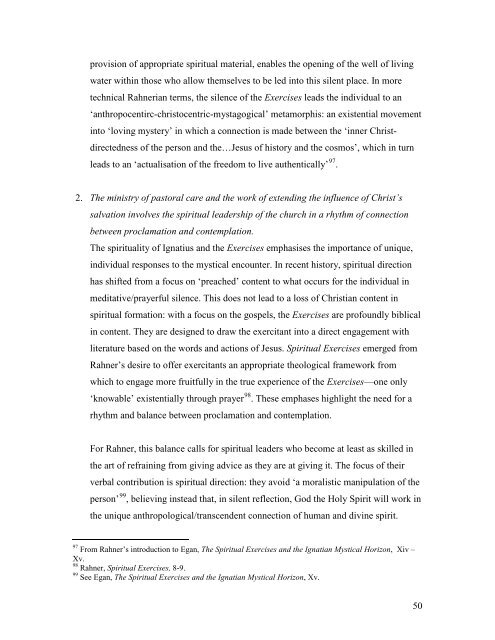Introductory notes for readers of this thesis - Theses - Flinders ...
Introductory notes for readers of this thesis - Theses - Flinders ...
Introductory notes for readers of this thesis - Theses - Flinders ...
Create successful ePaper yourself
Turn your PDF publications into a flip-book with our unique Google optimized e-Paper software.
provision <strong>of</strong> appropriate spiritual material, enables the opening <strong>of</strong> the well <strong>of</strong> livingwater within those who allow themselves to be led into <strong>this</strong> silent place. In moretechnical Rahnerian terms, the silence <strong>of</strong> the Exercises leads the individual to an‘anthropocentirc-christocentric-mystagogical’ metamorphis: an existential movementinto ‘loving mystery’ in which a connection is made between the ‘inner Christdirectedness<strong>of</strong> the person and the…Jesus <strong>of</strong> history and the cosmos’, which in turnleads to an ‘actualisation <strong>of</strong> the freedom to live authentically’ 97 .2. The ministry <strong>of</strong> pastoral care and the work <strong>of</strong> extending the influence <strong>of</strong> Christ’ssalvation involves the spiritual leadership <strong>of</strong> the church in a rhythm <strong>of</strong> connectionbetween proclamation and contemplation.The spirituality <strong>of</strong> Ignatius and the Exercises emphasises the importance <strong>of</strong> unique,individual responses to the mystical encounter. In recent history, spiritual directionhas shifted from a focus on ‘preached’ content to what occurs <strong>for</strong> the individual inmeditative/prayerful silence. This does not lead to a loss <strong>of</strong> Christian content inspiritual <strong>for</strong>mation: with a focus on the gospels, the Exercises are pr<strong>of</strong>oundly biblicalin content. They are designed to draw the exercitant into a direct engagement withliterature based on the words and actions <strong>of</strong> Jesus. Spiritual Exercises emerged fromRahner’s desire to <strong>of</strong>fer exercitants an appropriate theological framework fromwhich to engage more fruitfully in the true experience <strong>of</strong> the Exercises—one only‘knowable’ existentially through prayer 98 . These emphases highlight the need <strong>for</strong> arhythm and balance between proclamation and contemplation.For Rahner, <strong>this</strong> balance calls <strong>for</strong> spiritual leaders who become at least as skilled inthe art <strong>of</strong> refraining from giving advice as they are at giving it. The focus <strong>of</strong> theirverbal contribution is spiritual direction: they avoid ‘a moralistic manipulation <strong>of</strong> theperson’ 99 , believing instead that, in silent reflection, God the Holy Spirit will work inthe unique anthropological/transcendent connection <strong>of</strong> human and divine spirit.97 From Rahner’s introduction to Egan, The Spiritual Exercises and the Ignatian Mystical Horizon, Xiv –Xv.98 Rahner, Spiritual Exercises, 8-9.99 See Egan, The Spiritual Exercises and the Ignatian Mystical Horizon, Xv.50















